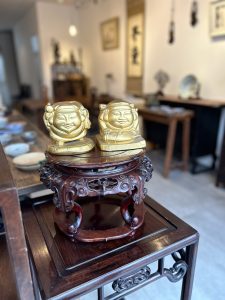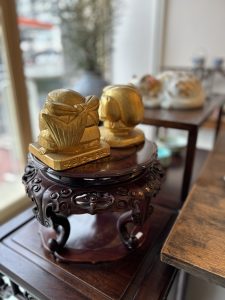自分の当たり前は当たり前ではありませんでした(愛知県名古屋市千種区姫池通 骨董買取 古美術風光舎)
2024.01.10
皆さまこんにちは。スタッフHでございます。
本日1月10日と言えば十日えびすですね。という挨拶は関西以外では通じないことを名古屋に来て知りました。

生まれてこの方、当たり前だと思っていた行事が他の地域では全く行われていないと知った時の驚きは言葉にできません。地域ごとに多種多様な風習や祭礼が存在することが日本文化の特徴でもあり面白いところでもあります。
以前関東地方の友人に11月の浅草の「鷲神社の酉の祭」を知らないと言うと、かなり驚かれました。自分にとっての当たり前は他の人の当たり前ではないのですね。
ここ名古屋の熱田神宮での初えびすは「五日えびす」とも言われ、摂社上知我麻(かみちかま)神社境内にある大国主社(おおくにぬししゃ)・事代主社(ことしろぬししゃ)の祭儀です。五日、午前零時から行われ、縁起物の「一番札」や「福熊手」を買い求める多くの参拝者で境内は終日賑わいをみせ、熱気に包まれます。
えびす祭りは七福神の一人である恵比須様に商売繁盛や大漁を祈願するお祭りです。恵比須様は右手に釣り竿(笹)、左手に鯛を持ち、漁業の神様とされ、豊かな福耳、福々しいお顔を持った神様です。
風光舎にも大黒天様と恵比須様がいらっしゃいます。明治時代の民芸品です。
風光舎の恵比須様は笹は持っておらず、鯛の上にどっしりと座っていらっしゃいます。愛らしくも貫禄のあるお姿です。

関西の十日えびすは「えべっさん」という愛称で親しまれ、9日の宵戎(よいえびす)、10日の本戎、11日の残り福と三日間、お正月並みの賑わいをみせ、縁起物の福笹や熊手などを持った人であふれます。境内では「♪年のはじめのえべっさん、商売繁盛で笹もってこい♪」と賑やかなえびす囃子が流れ、商売繁盛を願って福娘から福笹を授かります。
歴史的には参拝者が自分の笹を持参し、それに神社側が縁起物を付けるという習慣がありました。この習慣が「笹を持ってくる」という言い回しとして残っています。福笹の由来は恵比須様が釣り竿として笹を使っているためです。
大阪の今宮戎神社は1月10日の一日だけでも100万人の参拝者が訪れることでも知られています。毎年約40人の「福娘」が選ばれ、倍率は70倍ともいわれ狭き門となっています。十日えびすで福笹を授けてくれたり、挨拶回りや餅まき行事、舞楽奉納式など年間を通じて神社の様々な神事参加します。現在は分かりませんが昔は福娘を選ぶ番組がテレビで放映され、家族で観ていた記憶があります。子供の頃は憧れたものです。
また兵庫県の西宮神社は全国に3500社ある「えびす神社」の総本社であり、毎年1月10日に行われる「開門神事福男選び」が有名です。十日えびすを知らないという方も福男はニュースなどでご存知ではないでしょうか。実は女性の参加者もいるそうですが、「福女」の認定はまだいないそうです。
朝6時の開門と同時に本殿に向かって走り、一位をとり福男、福女に選ばれると縁起が良いとされています。開門神事でのスタート位置はくじ引きできめられますので、前の方の番号のくじを引いたところで既に「福」を授かっているとも言われます。今年は大学生の陸上部所属の男性が福男となったようですね。いつか福女も現れてほしいものです。
それでは、またお会いしましょう。
Hello everyone. This is Staff H.
Today, January 10, is Tokaebisu, or the festival of the tenth day of the month of Ebisu. I have come to know that the greeting “Toka Ebisu” is not understood outside of the Kansai region when I came to Nagoya.
I can’t express my surprise when I learned that this event, which I have taken for granted since I was born, is not practiced at all in other areas of Japan. The existence of a wide variety of customs and festivals in each region is a characteristic and interesting aspect of Japanese culture.
When I once told a friend from the Kanto region that I had never heard of the “Tori-no-matsuri (rooster festival) at Washi-jinja Shrine” in Asakusa in November, he was quite surprised. What is natural to me is not natural to others.
The Hatsuebisu Festival at Atsuta Shrine in Nagoya is also called “Itsuka-ebisu,” and is held at the Okuninushi-sha and Kotoshironushi-sha shrines located on the grounds of Kamichigama Shrine, a regent shrine. The festival starts at midnight on the fifth day of the month, and the shrine grounds are crowded with visitors throughout the day, eager to buy lucky charms such as “Ichiban-fuda” and “Fuku-kumade” (lucky rakes).
Ebisu Festival is a festival to pray to Ebisu-sama, one of the Seven Gods of Good Fortune, for prosperity in business and a good catch of fish. Holding a fishing rod (bamboo) in his right hand and a sea bream in his left, Ebisu-sama is regarded as the god of fishery, and is said to have abundant ears and a blessed face.
Daikoku-sama and Ebisu-sama are also present here at Fukosha. They are folk art from the Meiji era.
Ebisu-sama of the Fukosha is not holding a bamboo branch, but is sitting on top of a sea bream. It is a lovely figure.
Tokaebisu in Kansai is nicknamed “Ebessan,” and the three-day festival, Yoebisu on the 9th, Hon Ebisu on the 10th, and Zanbuku on the 11th, is as bustling as New Year’s Day, with people carrying lucky bamboo branches and rakes for good luck. The shrine grounds are filled with people carrying lucky bamboo branches, rakes, and other good luck charms.
Historically, it was customary for visitors to bring their own bamboos, to which the shrine would attach lucky charms. This custom has remained as the phrase “bring your own bamboos. The origin of the lucky bamboo branch comes from the fact that Ebisu-sama uses the bamboo branch as a fishing rod.
Imamiya Ebisu Shrine in Osaka is known for attracting one million visitors on January 10 alone. Every year, about 40 “fuku-musume” are chosen, and the number of applicants is said to be as high as 70 times higher than that of the previous year, making it a very narrow gate to the shrine. They give out lucky bamboo branches on Tokaebisu, and participate in various Shinto rituals throughout the year, such as greeting, mochi-maki (rice cake throwing) events, and dedication ceremonies of bugaku (traditional Japanese dance and music). I don’t know about now, but in the past, I remember watching a TV program on which a lucky girl was chosen, and my family and I would watch it together. I remember watching it as a child and longing to be a part of it.
Nishinomiya Shrine in Hyogo Prefecture is the head shrine of the 3,500 “Ebisu Shrines” in Japan, and is famous for the “Kaimon Jinji Fukuotoko-Selection” held every year on January 10. Even if you have never heard of Tokaebisu, you may have heard of Fukuo through news and other media. In fact, there are some female participants, but they have not yet been certified as “lucky women.
It is believed that it is good luck to run toward the main shrine at the opening of the gate at 6:00 a.m. and be chosen as a “Fuku-otoko” or “Fuku-onna” by winning the first place. The starting position at the opening ceremony is decided by lot drawing, so it is said that if you draw the lot with the number in the front, you have already received “good fortune. This year, a university student who belongs to the track team seems to be the lucky man. I hope a lucky woman will appear someday.
*******************
ご実家の整理やお片付けなどをされている方のご相談などが多くございます。
お片付けなどくれぐれもご無理のないようになさってくださいませ。
風光舎では古美術品や骨董品の他にも絵画や宝石、趣味のお品など様々なジャンルのものを買受しております。
お片付けをされていて、こういうものでもいいのかしらと迷われているものでも、どうぞお気軽にご相談下さいませ。
また風光舎は、出張買取も強化しております。ご近所はもちろん、愛知県内、岐阜県、三重県その他の県へも出張いたします。
まずは、お電話お待ちしております。
愛知県名古屋市千種区姫池通
骨董 買取【古美術 風光舎 名古屋店】
TEL052(734)8444
10:00-18:00 OPEN
#出張買取#骨董#古美術#骨董品#絵画#版画#茶道具#刀剣#彫刻

